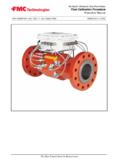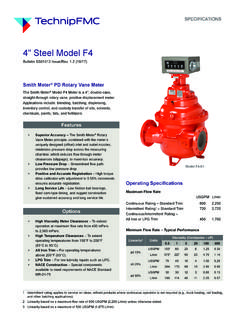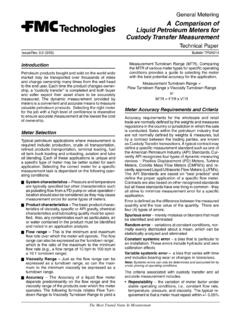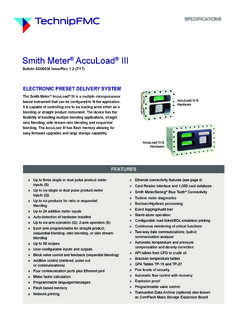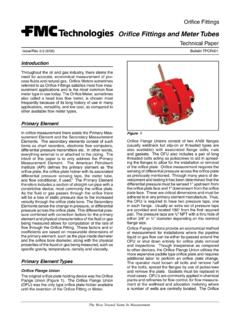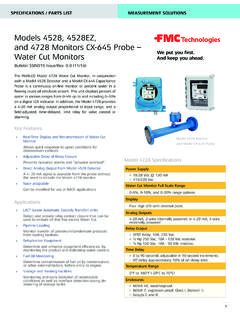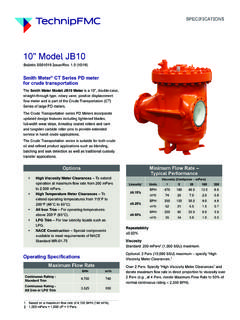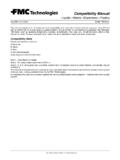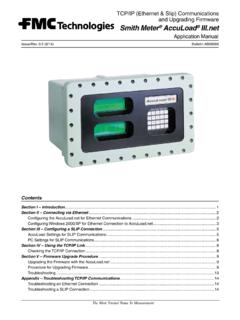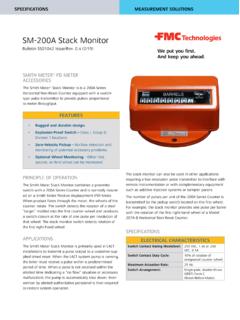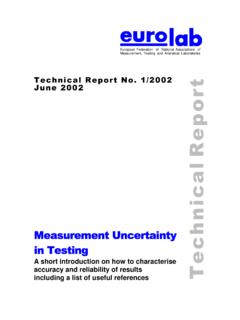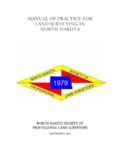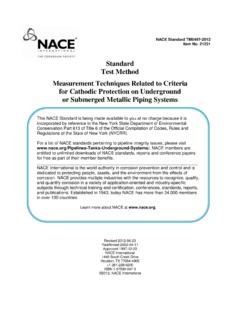Transcription of Smith Meter Proving Liquid Ultrasonic Flow Meters for ...
1 Technical PaperSmith Meter Liquid Ultrasonic MetersProving Liquid Ultrasonic Flow Meters for custody transfer MeasurementIssue/Rev. (1/10) Bulletin TPLS002 The Most Trusted Name In MeasurementIntroduction Liquid Ultrasonic flow Meters (LUFMs) continue to gain popularity in petroleum measurement with the promise of high accuracy and low maintenance. These are favor-able features, but because of the high volume and value of petroleum products, buyers and sellers must have a high level of confidence in the accuracy of measure-ment. This assurance in custody transfer measurement is gained by adherence to the standards, procedures and methods that define the measurement process. There are two fundamental ways that petroleum prod-ucts are measured: statically and dynamically. The measured volume determined by either method must be validated at operating conditions and traced to a fundamental standard. In a static system the product is transferred to a tank or similar container.
2 After the trans-action is completed the volume can be measured and validated by a suitable method. In a dynamic system PD, turbine or Ultrasonic Meters provide instantaneous information on the rate and volume of the transfer . As with static methods the measurement results must be validated by a suitable method. A key difference between a static and dynamic measure-ment is time. A static measurement is similar to a bank transaction, where the cash draw can be pulled and veri-fied at any time. When a static transaction is complete, there is time to review the measured volume, and if an error is suspected, the volume can be re-measured. With a dynamic system, the measurement must be right the first time; there are no means to re-measure the volume. The Proving system and process are essential in both static and dynamic measurement systems to validate the accuracy of volume measured. There are various worldwide standards and regulations that define the measurement system requirements, but they are fun-damentally the same.
3 Each is traceable to a national standard, which in turn, is traceable to the international standard. In dynamic measurement systems this link is the prover volume. There are gravimetric and volu-metric methods where the prover volume is traceable the International Bureau of Legal Metrology (BIML). The technical arm of the bureau is OIML (International Organization for Legal Metrology). This is an intergov-ernmental organization that deals with all aspects of legal metrology. It has 59 member states and 50 cor-responding members. In this way all the countries are tied to the same weights and measurement standards, which facilitates world trade. The various measurement standards either directly or indirectly define the accuracy requirements over a range of operating conditions which include: flow rate, viscos-ity, temperature, pressure, piping configurations, etc. It is therefore important in the Proving process to define both the operating conditions and the accuracy require-ments because they are interdependent.
4 A change in operating conditions can affect the Meter s accuracy. The greater the change in operating conditions, the more uncertainty is introduced into the measurement . As a general rule, the Meter must be proven at operat-ing conditions to validate its accuracy with the highest degree of confidence. The object of all custody transfer Meters is the same: highly accurate measurement , but the procedures to achieve the results may vary with the different Meter technologies. This paper will focus on the standards, pro-cedures and methods used to prove Ultrasonic Meters . custody transfer RequirementsCustody transfer refers to the fiscal measurement used to determine the quantity and financial value of a petro-leum product transaction (delivery). The custody transfer requirements can be of two types:LegalDefined by Weights & Measures (W&M) in the country or jurisdiction in which the sale is conducted. The vari-ous W&M codes and regulations control the wholesale and retail trade requirements to facilitate fair trade.
5 The regulations and accuracy requirements vary widely be-tween countries and commodities, but they all have one common characteristic traceability. There is always a procedure that defines the validation process where the duty Meter is compared to a standard that is traceable to the legal metrology agency of the respective region. The Meters for wholesale and retail trade are normally smaller (4 and under) to handle volume flow rates of under 2,800 l/m (750 gpm). These applications are out-side the range of current Liquid Ultrasonic Meters and therefore will not be addressed in this paper. ContractA contract is a written agreement between buyers and sellers that defines the measurement requirements. These are large-volume sales between operating com-panies where refined products and crude oils are trans-ported by marine, pipeline or rail. Since even a small error in measurement can amount to a large financial difference, custody transfer measurement must be at the highest level of accuracy possible.
6 Because of the critical nature of these measurements, petroleum com-panies around the world have developed and adopted standards to meet the industry s needs. A typical contract may define a specific measurement standard such as the American Petroleum Industry Issue/Rev. (1/10)Page 2 TPLS002(API) Petroleum measurement Standards or an OIML standard that is tied to the International Standards Organization (ISO). These standards include all of the equipment, required and detail the process to achieve an acceptable level of measurement . Specifying a standard in a contract eliminates the need to enumerate many details concerning the equipment and measurement process that are common industry practice. For example, API Standards are based on Best They define the proper application parameters of a specific flow Meter from field experience. OIML stan-dards are performance based. They set quantitative conditions that any custody transfer Meter must meet.
7 To gain approval a specific size and type of Meter must be tested over the operating range by a notified body (qualified testing agency) that issues a pattern test report. The pattern test report is then submitted to the respective weights and measures authority as part of the application for approval. Even though the standards may appear to vary widely, they have two fundamental points in common: 1. They all strive to maintain a minimum measurement error for a specific application and 2. They require traceability to national/international metrology standards by Proving the terms of accuracy, which is expressed as uncertainty, a good API system would typically have a +/- ex-tended uncertainty. OIML requires a minimum system uncertainty of +/- over a wide operating range. For large volume transfers, more precise measurement is required, so the systems are proven over a more lim-ited range of operating conditions, typically achieving a +/- extended uncertainty the same as a system using API Standards.
8 measurement Definitions The terminology associated with measurement can be confusing, but is important in understanding the mea-surement process. Two good sources for measurement terminology are:API Manual of Petroleum measurement Standards Chapter 1 Vocabulary and Chapter 13 Statistical Aspects of Measuring and Sampling VIM International Vocabulary of Basic and General Terms in Metrology, commonly known as VIM, which is accepted by the international community of legal metrology Included below is a summary of the key terminology used in evaluating a Meter s performance. Definitions were selected from both sources. As expected the ter-minology is similar because accurate measurement is essentially the same worldwide. Accuracy [API ]: the ability of the measuring instru-ment to indicate values closely approximating the true value of the quantity of measurement [VIM ]: closeness of the agreement between the result of a measurement and the value of the measurand.
9 Measurand [API ] is a physical quantity that has been or is to be (of results of measurements) [VIM ]: closeness of the agreement between the results of suc-cessive measurements of the same measurand carried out under the same conditions of measurement which include the same: measurement procedure, observer, measuring instrument, conditions and location over a short period of time. API [ ] adds ..the ability of a Meter and prover system to repeat its registered volume during a series of consecutive Proving runs under constant operating conditions. Reproducibility (of results of measurements) [VIM ]: closeness of the agreement between the results of measurements of the same measurand car-ried out under changed conditions of measurement . A valid statement of reproducibility requires specification of the conditions changed. The changed conditions may include: principle of measurement , method of measure-ment, observer, measuring instrument, reference stan-dard, location, conditions of use and time.
10 Results here are usually understood to be corrected results. API [ ] adds ..the ability of a Meter and prover system to reproduce results over a long period of time in service where the range of pressure temperature, flow rate, and physical properties of the metered Liquid is negligibly small. Linearity of a Meter [API ]: the ideal accuracy curve of volume Meters is a straight line denoting a constant Meter factor. Meter linearity is expressed as the total range of deviation of the accuracy curve from a straight line between the minimum and maximum recommended flow rates. Bias [API 13] is any influence on a result that produces an incorrect approximation of the true value of the variable being measured. Bias is the result of systemic error. Error (of measurement ) [VIM ] is the result of a measurement minus the value of the measurand. Since the value of the measurand cannot be determined, in practice a conventional value is used. Types of Error [API 13 edited]: the difference between the measured quantity and the true value of the quantity includes all the errors associated with the measurement process the person taking the measurement , the pro-cess, the instruments and changes in conditions during the period of measurement .
